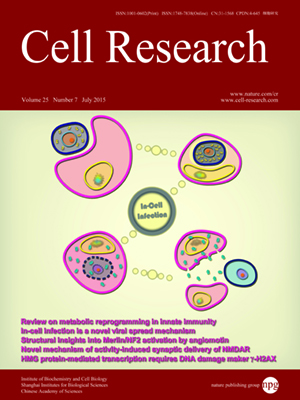
Volume 25, No 7, Jul 2015
ISSN: 1001-0602
EISSN: 1748-7838 2018
impact factor 17.848*
(Clarivate Analytics, 2019)
Volume 25 Issue 7, July 2015: 851-863
ORIGINAL ARTICLES
Generation of fertile offspring from Kitw/Kitwv mice through differentiation of gene corrected nuclear transfer embryonic stem cells
Yan Yuan1,*, Quan Zhou1,*, Haifeng Wan2,*, Bin Shen1,*, Xuepeng Wang2,3, Mei Wang2,4, Chunjing Feng2,3, Mingming Xie2,5, Tiantian Gu2, Tao Zhou1, Rui Fu2, Xingxu Huang6, Qi Zhou2, Jiahao Sha1 and Xiao-Yang Zhao2
1State Key Laboratory of Reproductive Medicine, Department of Histology and Embryology, Nanjing Medical University, Nanjing, Jiangsu 210029, China
2State Key Laboratory of Reproductive Biology, Institute of Zoology, Chinese Academy of Sciences, Beijing 100101, China
3Graduate School of Chinese Academy of Sciences, Beijing 100049, China
4College of Life Sciences, Hunan Normal University, Changsha, Hunan 410081, China
5College of Life Science, Anhui University of China, Hefei, Anhui 230601, China
6MOE Key Laboratory of Model Animal for Disease Study, Model Animal Research Center of Nanjing University, Nanjing Biomedical Research Institute, National Resource Center for Mutant Mice, Nanjing, Jiang Su 210061, China
Correspondence: Qi Zhou ; Jiahao Sha ; Xiao-Yang Zhao(qzhou@ioz.ac.cn ; shajh@njmu@edu.cn ; xyzhao@ioz.ac.cn)
Genetic mutations could cause sperm deficiency, leading to male infertility. Without functional gametes in the testes, patients cannot produce progeny even with assisted reproduction technologies such as in vitro fertilization. It has been a major challenge to restore the fertility of gamete-deficient patients due to genetic mutations. In this study, using a
Kitw/
Kitwv mouse model, we investigated the feasibility of generating functional sperms from gamete-deficient mice by combining the reprogramming and gene correcting technologies. We derived embryonic stem cells from cloned embryos (ntESCs) that were created by nuclear transfer of
Kitw/
Kitwv somatic cells. Then we generated gene-corrected ntESCs using TALEN-mediated gene editing. The repaired ntESCs could further differentiate into primordial germ cell-like cells (PGCLCs)
in vitro. RFP-labeled PGCLCs from the repaired ntESCs could produce functional sperms in mouse testes. In addition, by co-transplantation with EGFP-labeled testis somatic cells into the testes where spermatogenesis has been chemically damaged or by transplantation into
Kitw/
Kitwv infertile testes, non-labeled PGCLCs could also produce haploid gametes, supporting full-term mouse development. Our study explores a new path to rescue male infertility caused by genetic mutations.
10.1038/cr.2015.74
FULL TEXT | PDF
Browse 2152


